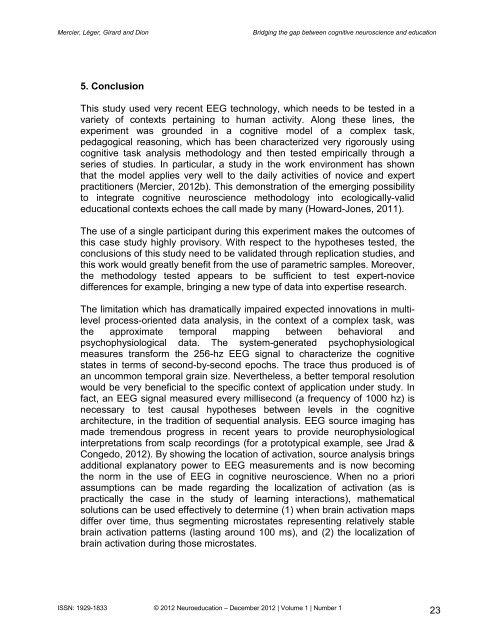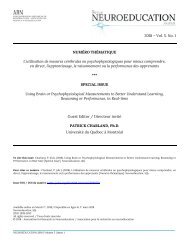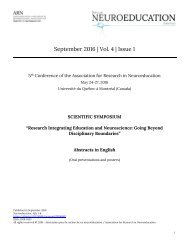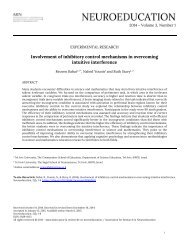Neuroeducation_2012_vol-1_no-1_full
Neuroeducation journal - Volume 1, Issue 1 (2012) - 144 pages
Neuroeducation journal - Volume 1, Issue 1 (2012) - 144 pages
You also want an ePaper? Increase the reach of your titles
YUMPU automatically turns print PDFs into web optimized ePapers that Google loves.
Mercier, Léger, Girard and Dion<br />
Bridging the gap between cognitive neuroscience and education<br />
5. Conclusion<br />
This study used very recent EEG tech<strong>no</strong>logy, which needs to be tested in a<br />
variety of contexts pertaining to human activity. Along these lines, the<br />
experiment was grounded in a cognitive model of a complex task,<br />
pedagogical reasoning, which has been characterized very rigorously using<br />
cognitive task analysis methodology and then tested empirically through a<br />
series of studies. In particular, a study in the work environment has shown<br />
that the model applies very well to the daily activities of <strong>no</strong>vice and expert<br />
practitioners (Mercier, <strong>2012</strong>b). This demonstration of the emerging possibility<br />
to integrate cognitive neuroscience methodology into ecologically-valid<br />
educational contexts echoes the call made by many (Howard-Jones, 2011).<br />
The use of a single participant during this experiment makes the outcomes of<br />
this case study highly provisory. With respect to the hypotheses tested, the<br />
conclusions of this study need to be validated through replication studies, and<br />
this work would greatly benefit from the use of parametric samples. Moreover,<br />
the methodology tested appears to be sufficient to test expert-<strong>no</strong>vice<br />
differences for example, bringing a new type of data into expertise research.<br />
The limitation which has dramatically impaired expected in<strong>no</strong>vations in multilevel<br />
process-oriented data analysis, in the context of a complex task, was<br />
the approximate temporal mapping between behavioral and<br />
psychophysiological data. The system-generated psychophysiological<br />
measures transform the 256-hz EEG signal to characterize the cognitive<br />
states in terms of second-by-second epochs. The trace thus produced is of<br />
an uncommon temporal grain size. Nevertheless, a better temporal resolution<br />
would be very beneficial to the specific context of application under study. In<br />
fact, an EEG signal measured every millisecond (a frequency of 1000 hz) is<br />
necessary to test causal hypotheses between levels in the cognitive<br />
architecture, in the tradition of sequential analysis. EEG source imaging has<br />
made tremendous progress in recent years to provide neurophysiological<br />
interpretations from scalp recordings (for a prototypical example, see Jrad &<br />
Congedo, <strong>2012</strong>). By showing the location of activation, source analysis brings<br />
additional explanatory power to EEG measurements and is <strong>no</strong>w becoming<br />
the <strong>no</strong>rm in the use of EEG in cognitive neuroscience. When <strong>no</strong> a priori<br />
assumptions can be made regarding the localization of activation (as is<br />
practically the case in the study of learning interactions), mathematical<br />
solutions can be used effectively to determine (1) when brain activation maps<br />
differ over time, thus segmenting microstates representing relatively stable<br />
brain activation patterns (lasting around 100 ms), and (2) the localization of<br />
brain activation during those microstates.<br />
ISSN: 1929-1833 © <strong>2012</strong> <strong>Neuroeducation</strong> – December <strong>2012</strong> | Volume 1 | Number 1<br />
23








